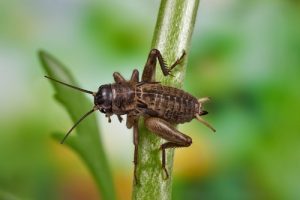Can Insects Hear?
By Chris Williams on August 23, 2011.
Good question, right? If you think about it, you’ll realize that many insects must be able to hear. What about those noisy insects that chirp or have mating or territorial calls? Crickets, cicadas, and katydids obviously can hear each other. That’s what their “singing” is all about.
Insects can detect airborne sound in one of two ways: through sensory hairs on their bodies or through tympanal organs. In mosquitoes, for example, the long hairs on their antennae detect certain sounds, generally only sounds in low frequencies. On the other hand, the tympanal organ is very sensitive to a large range of sound and can even detect frequencies in the ultrasonic range.
 A tympanal organ is a very thin membrane with air on both sides of it, very much like an eardrum. It’s this sound-detecting organ that enables the singing and chirping insects to tune into each other. In cicadas and certain grasshoppers, this sound membrane is located on the abdomen. In crickets, the tympanal organs are two vertical slits on the front legs. In one research study, it was discovered that, using its tympanal organ, a bushcricket could hear an approaching bat long before the bat could detect an echo from the flying insect.
A tympanal organ is a very thin membrane with air on both sides of it, very much like an eardrum. It’s this sound-detecting organ that enables the singing and chirping insects to tune into each other. In cicadas and certain grasshoppers, this sound membrane is located on the abdomen. In crickets, the tympanal organs are two vertical slits on the front legs. In one research study, it was discovered that, using its tympanal organ, a bushcricket could hear an approaching bat long before the bat could detect an echo from the flying insect.
An insect doesn’t respond to changes in the frequency or pitch of a sound but it does respond to changes in the amplitude modulation or the rhythmic features of a sound. In fact, it’s the rapid changes in the intensity and rhythm that make an insect’s “song” what it is.
There’s still another way that insects can hear, and that’s through surface vibrations. Bees, for example, really don’t hear airborne sounds, but they can detect sound vibrations through the ground or other surface on which they’re resting.